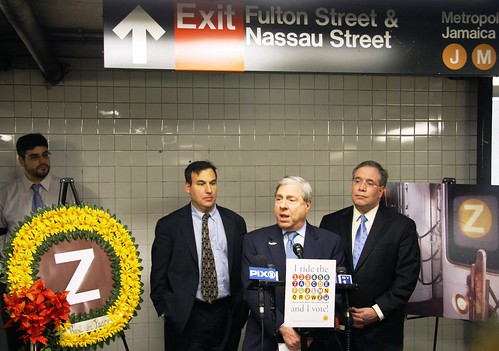Attend an MTA hearing on the fare hikes and service cuts and one the many documents available to the public is bound to be 150-page tome entitled “Proposed Station Changes.” That work of art, available here as a PDF, details every single station booth that would shutter under the MTA’s Doomsday budget, and I have to wonder if there is more to it than meets the eye.
For the most part, the plans look as the one above — which you can click to enlarge — does. Stations that currently enjoy station agents at more than one point of entrance will see one of those permanent positions vanish in a puff of smoke. From Union St. to Union Turnpike, stations will see far fewer permanent employees and, in fact, far fewer employees in general.
According to the MTA’s figures, New York City Transit can reduce 808 positions by shuttering what they view are unnecessary booths. The plan would eliminate 570 red-vested Station Customer Assistance workers and 26 station supervisors. Meanwhile, NYC Transit also plans to shutter 29 redundant booths at 36 stations which multiple booths and converting 13 others at high-volume stations — Times Square, Penn Station, etc. — to part-time position. In total, those cuts will eliminate another 212 jobs.
Here’s where it gets interesting. According to the MTA’s report, these cuts will save $25.1 million in 2009 and $52 million in 2010. The savings sound substantial until you realize that $52 million is just 4.33 percent of the MTA’s overall $1.2 billion deficit. Much like the not-so-cost efficient service cuts, the MTA is reducing a lot of staff for little overall savings. I guess every little bit helps.
Meanwhile, the report contains an interesting line. “All stations/complexes will retain one full-time booth,” it says. That includes the above, stations similar to 25th St. along the Fourth Ave. line in Brooklyn. These stations are generally one way on one side, one way on the other with no free transfer between the two. If you have a problem on the southbound side of 25th St., under the MTA’s new plan, you’ll have to leave the station, cross Fourth Ave. and find the station agent in the booth on the northbound side. That’s hardly a model of efficiency.
Now, it’s easy to argue that many of these positions should be cut to part-time anyway. The station agents, after all, are more psychologically preventative than physically useful, but they do play rolls in the event of an emergency. But what if this is just a ploy by the MTA to draw attention to their economic plight? By making the station agent system ruthlessly inefficient as they would at many non-crossover stations, the MTA is begging Albany to intervene before getting around and getting information in the subways becomes a very expensive hassle.
This Doomsday budget really is bleak, and the more we look at it, the more we find not to look. We need a Ravitch-inspired bailout (or better) and soon. March 25 draws ever nearer day by day.


 During last week’s public hearing on the fare hikes and service cuts, a common theme emerged concerning the MTA’s Access-A-Ride paratransit service. With plans to double the paratransit fares on the table, advocates for the disabled and disabled riders all said the same thing: Don’t balance the budget on the backs of those least able to get around town.
During last week’s public hearing on the fare hikes and service cuts, a common theme emerged concerning the MTA’s Access-A-Ride paratransit service. With plans to double the paratransit fares on the table, advocates for the disabled and disabled riders all said the same thing: Don’t balance the budget on the backs of those least able to get around town.





















